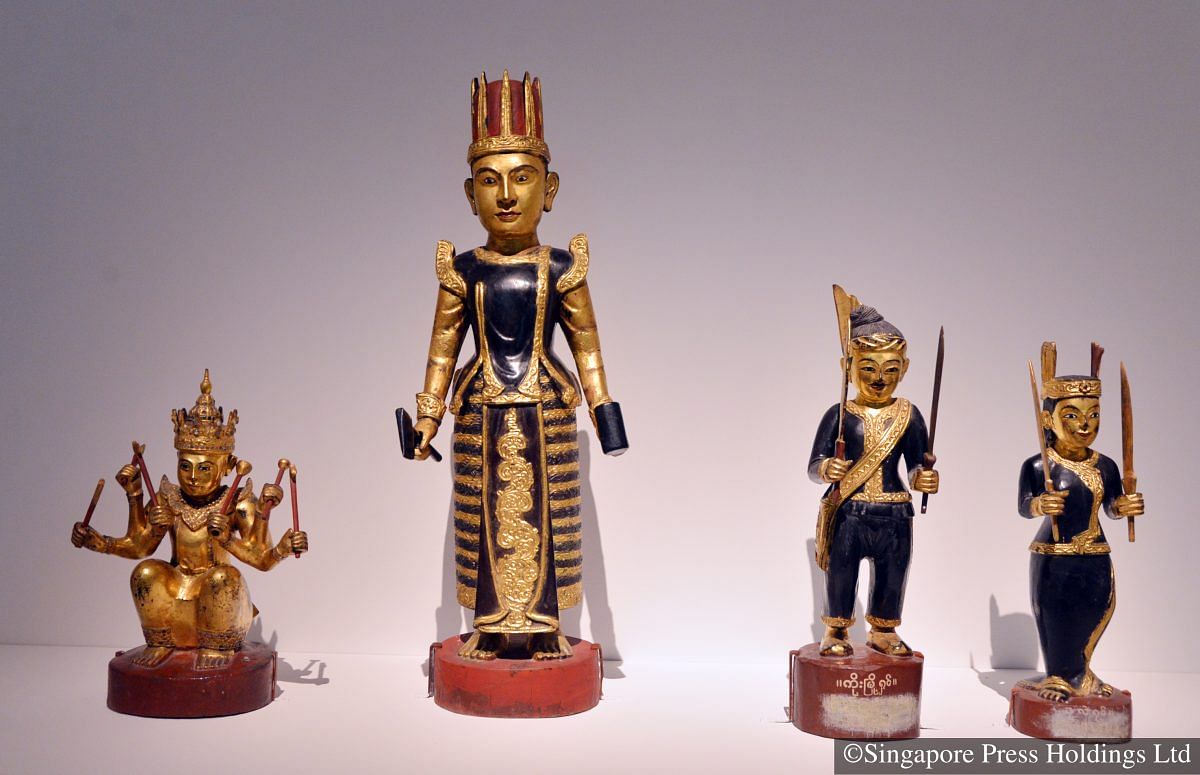[dropcap size=small]F[/dropcap]eaturing artefacts from sacred sandstone statues to ornate, gilded plaques, the latest exhibition at the Asian Civilisations Museum tells the story of Myanmar’s art and culture through the centuries.
“Cities And Kings: Ancient Treasures From Myanmar” has been five years in the making, with the museum partnering four institutions in Myanmar to borrow 32 artefacts out of the 60 on display. Of these, 14 had never before travelled out of Myanmar. The other artefacts are from the Asian Civilisations Museum’s national collection and a private collection in Singapore.
The exhibition takes visitors through three of the most significant eras in Myanmar’s history: the formative Pyu and Mon periods from the fourth to ninth century; the famed Bagan period from the ninth to 14th century when Buddhist temple architecture flourished; and the Mandalay period in the 19th century with its celebrated courtly arts.
The artefacts evolve from era to era — moving from carved stone artefacts of the Bagan period to increasingly sophisticated materials such as chiselled marble in the Inwa period and engraved metal from the Mandalay period. Mandalay’s role as the royal capital of the kingdom ended in 1885 when Myanmar was annexed by the British and put under colonial rule. The country became independent in 1948.
Dr Stephen Murphy, 41, curator of the exhibition, said: “We wanted not only star pieces that would capture the public’s imagination visually and aesthetically, but also pieces that told important historical moments.”
He emphasised the importance of understanding Myanmar’s rich culture, given that it is one of Singapore’s South-east Asian neighbours. He said: “There are a lot of Myanmar nationals in Singapore. There are shared cultural values in terms of Buddhism and Hinduism. Old colonial Rangoon also has similarities with Singapore as prevalent port cities. Singaporeans could learn more about their own culture as well by seeing a neighbour’s culture.”
Nats
These are Myanmar’s indigenous spirits. Although since the mid-20th century, Buddhism has been Myanmar’s main religion for centuries, but Nats cannot be overlooked. They are indigenous animistic spirits that act as guardians of villages and households. According to Dr Stephen Murphy, curator of the exhibition, these artefacts are often left out of exhibitions on Myanmar. “They were included to reflect the presence of an indigenous religion that fused with Buddhism. Nats are still prevalent in Myanmar society,” he said.
Royal epistle case, Mandalay, 19th century, silver with precious stone inlay, National Museum, Yangon
Mandalay, the last royal capital of Myanmar from 1857 to 1885, was renowned for two forms of art that flourished in the past — silverware and lacquerware. This polished silver epistle case is a work of elegant craftsmanship mixed with Victorian elements. The figures carved on the metal are depicted in typical Mandalay court dress.
However, a European teapot can be spotted in use, instead of the traditional South-east Asian version known as a kendi. According to Dr Murphy, this is reflective of the period when British imports were fashionable in court.
Eight Great Events Plaque, Bagan, 11th to 13th century, dolomite, 16.5x11x3cm, National Museum, Naypyidaw
It may be one of the smallest items on display, but what it lacks in size, it makes up for with its astounding detail. The plaque follows the Eight Great Events in the Buddha’s life. The events are: Birth, Enlightenment, First Sermon, Descent From Tavatimsa Heaven, Taming of Nalagiri Elephant, Retreat to Paraleyyaka Forest, Miracle of the Double and Parinirvana (death). They are intricately carved onto the small plaque.
Buddha seated in dharmachakra mudra, Bagan, 11th century, sandstone, 115x68x26cm, Bagan Archaeological Museum
This carving of Buddha with tightly pursed lips, a prominent nose and a pinched face is indicative of the Bagan style. As one of the most sacred images of Buddha, it attracted worshippers and offerings even while on display in a museum. Dr Murphy said: “Before it was transported to Singapore, the museum staff in Myanmar prayed and made offerings for its safe journey. When it arrived, three monks came to welcome it. It blurs the lines between museum and place of worship.”
Warrior stele, Sri Ksetra, 4th to 6th century, stone, 140x95x11cm, National Museum, Yangon
An imposing, shield-like slab of stone greets visitors at the exhibition’s entrance. Figures of warriors brandishing weapons are carved on it. This image is associated with the Hindu god Vishnu and evokes notions of kingship. The combination of Hindu and Buddhist imagery reflects the stance of early forms of kingship in Sri Ksetra, where elites appeared to have supported both religious currents flowing into Myanmar from India at the time.
Cities and Kings: Ancient Treasures from Myanmar is at the Asian Civilisations Museum until 5 March 2017. Free entry in December 2016; ticketed after.
This article first appeared in The Straits Times.





